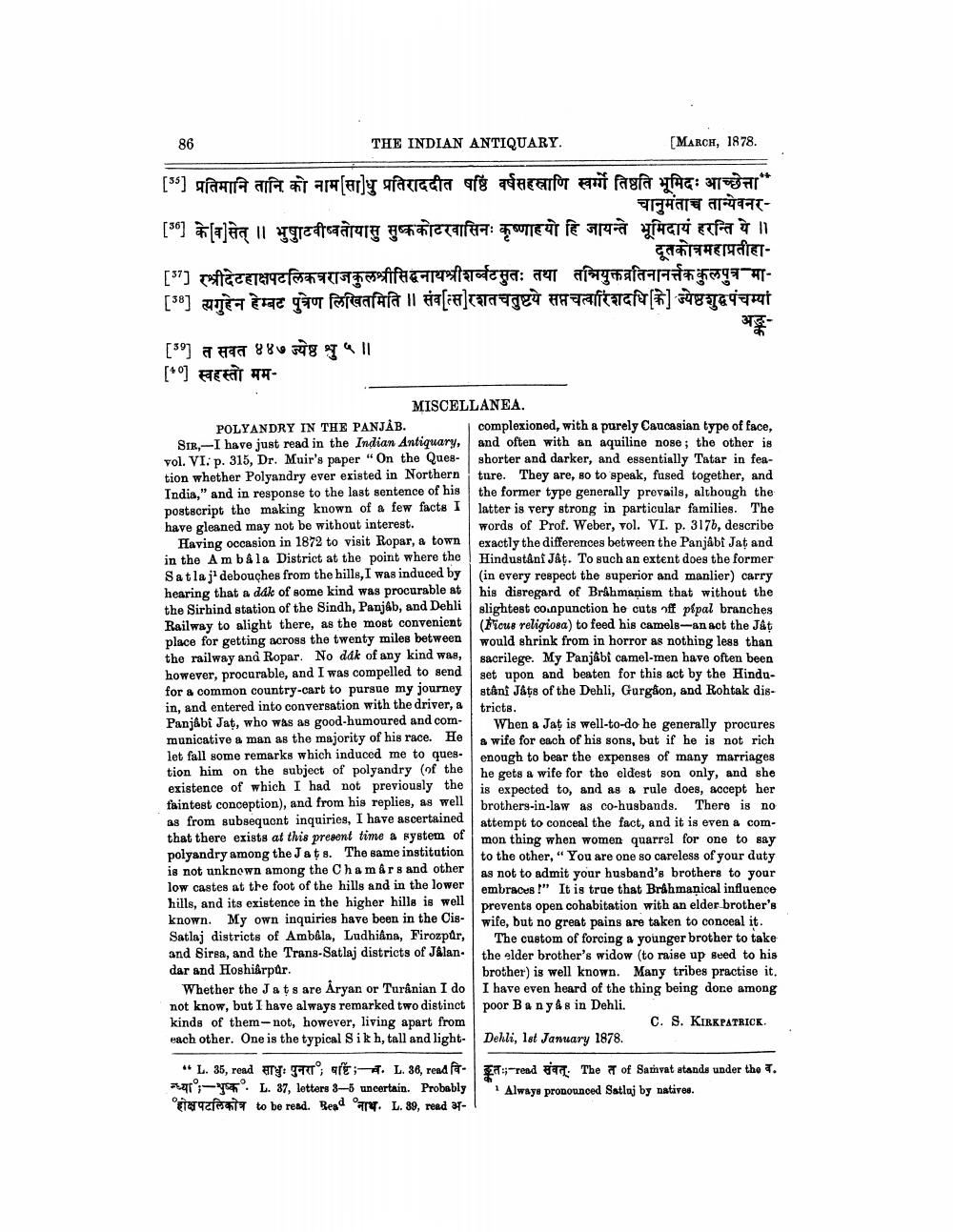________________
86
THE INDIAN ANTIQUARY.
[MARCH, 1878.
["] प्रतिमानि तानि को नाम [ साधु प्रतिराददीत पछि वर्षसहस्राणि स्वम तिष्ठति भूमिद आच्छेला " चानुमंताच तान्येवनर[0] [४] सेत् । भुवीवतीयासु मुष्ककोटरवासिनः कृष्णाची हि जायन्ते भूमिदा हरन्ति ये । दूतको महाप्रतीहा[7] श्रीदेहाक्षपटलिकत्रराजकुलश्रीसिद्धनाथश्रीशर्व्वटसुतः तथा तत्रियुक्तव्रतिनानर्त्तक कुलपुत्र मा[30] अगूहेन हेम्बट पुत्रेण लिखितमिति || संव[स] रशतचतुष्टये सप्तचत्वारिंशदधि [क] ज्येष्ठशुद्ध पंचम्पां
अङ्क
[39] त सवत ४४७ ज्येष्ठ श्रु ५ ॥ [0]] स्वहस्तो मम
MISCELLANEA.
POLYANDRY IN THE PANJAB.
SIR,-I have just read in the Indian Antiquary, vol. VI. p. 315, Dr. Muir's paper "On the Question whether Polyandry ever existed in Northern India," and in response to the last sentence of his postscript the making known of a few facts I have gleaned may not be without interest.
Having occasion in 1872 to visit Ropar, a town in the Am bâ la District at the point where the Satlaj' debouches from the hills, I was induced by hearing that a dák of some kind was procurable at the Sirhind station of the Sindh, Panjab, and Dehli Railway to alight there, as the most convenient place for getting across the twenty miles between the railway and Ropar. No dák of any kind was, however, procurable, and I was compelled to send for a common country-cart to pursue my journey in, and entered into conversation with the driver, a Panjabi Jat, who was as good-humoured and communicative a man as the majority of his race. He let fall some remarks which induced me to question him on the subject of polyandry (of the existence of which I had not previously the faintest conception), and from his replies, as well as from subsequent inquiries, I have ascertained that there exists at this present time a system of polyandry among the Jats. The same institution is not unknown among the Cha mârs and other low castes at the foot of the hills and in the lower hills, and its existence in the higher hills is well known. My own inquiries have been in the CisSatlaj districts of Ambâla, Ludhiana, Firozpur, and Sirea, and the Trans-Satlaj districts of Jalandar and Hoshiarpûr.
Whether the Ja ts are Aryan or Turânian I do not know, but I have always remarked two distinct kinds of them-not, however, living apart from each other. One is the typical Sik h, tall and light
** L.. 35, read साधुः पुनरा; षष्टिं; ब. L. 38, read वि - L. 37, letters 3-5 uncertain. Probably to be read. Read . L. 39, read ar
complexioned, with a purely Caucasian type of face, and often with an aquiline nose; the other is shorter and darker, and essentially Tatar in feature. They are, so to speak, fused together, and the former type generally prevails, although the latter is very strong in particular families. The words of Prof. Weber, vol. VI. p. 317b, describe exactly the differences between the Panjabi Jat and Hindustânî Jât. To such an extent does the former (in every respect the superior and manlier) carry his disregard of Brahmanism that without the slightest compunction he cuts off pipal branches (Ficus religiosa) to feed his camels-an act the Jât would shrink from in horror as nothing less than sacrilege. My Panjabi camel-men have often been set upon and beaten for this act by the Hindustâni Jats of the Dehli, Gurgaon, and Rohtak districts.
When a Jat is well-to-do he generally procures a wife for each of his sons, but if he is not rich enough to bear the expenses of many marriages he gets a wife for the eldest son only, and she is expected to, and as a rule does, accept her brothers-in-law as co-husbands. There is no attempt to conceal the fact, and it is even a common thing when women quarrel for one to say to the other, "You are one so careless of your duty as not to admit your husband's brothers to your embraces !" It is true that Brahmanical influence prevents open cohabitation with an elder brother's wife, but no great pains are taken to conceal it.
The custom of forcing a younger brother to take the elder brother's widow (to raise up seed to his brother) is well known. Many tribes practise it. I have even heard of the thing being done among poor B any&s in Dehli.
C. S. KIRKPATRICK.
Dehli, 1st January 1878.
ङ्कतः read संवत्. The त of Sarvat stands under tho व. 1 Always pronounced Satlaj by natives.




